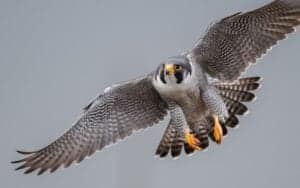The bald eagle is incredibly powerful and one of the largest birds on earth. They soar the skies with their long, broad wings and use their forceful talons (ten times stronger than a human’s grip) to lift animals up to four pounds. And while these stats are impressive for modern birds, did you know there was an eagle three times the size of a bald eagle? Discover everything there is to know about the Haast’s eagle, including its size, abilities, and how it went extinct.
Meet the Haast’s Eagle: How Does it Compare to a Bald Eagle?
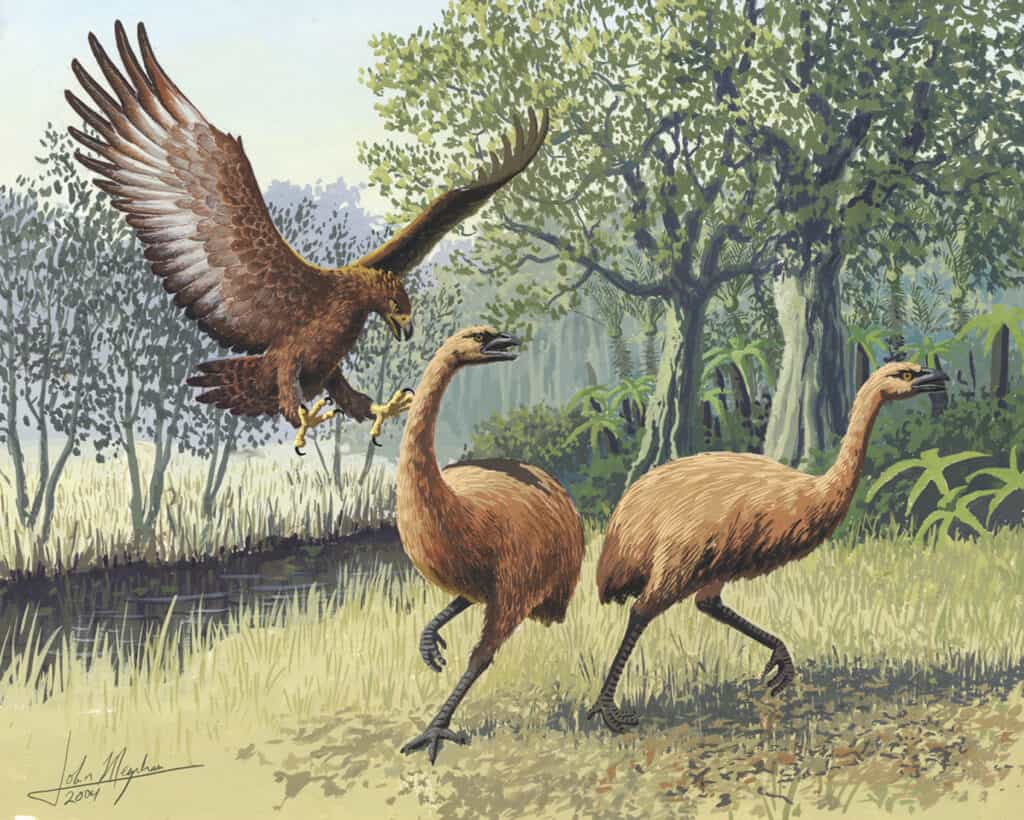
Haast’s eagle attacking New Zealand moa
©John Megahan, CC BY 2.5, via Wikimedia Commons – License
The Haast’s eagle is a giant extinct species of eagle endemic to the South Island of New Zealand. It soared among prehistoric fauna from sea level to the subalpine zone and was one of the top predators in terrestrial South Island ecosystems. There is evidence that the Haast’s eagle survived and evolved through multiple ice ages but went extinct around 500 to 600 years ago.
This eagle is unique as its feeding tactics were closer to a vulture’s, and it possessed a beak similar to an Andean condor’s. These giant eagles primarily hunted moa, an extinct group of large flightless birds. They had a specialized hunting technique where it would fly into the back of the moa’s legs before crushing the skull with its immense talons. It would then use its condor-like bill to devour the internal organs from the body cavity.
Bald eagles hunt much smaller prey, but they swoop from a high perch similar to the Haast’s eagle. Bald eagles swoop down, using their talon to snatch prey like fish and small rodents before constricting them.
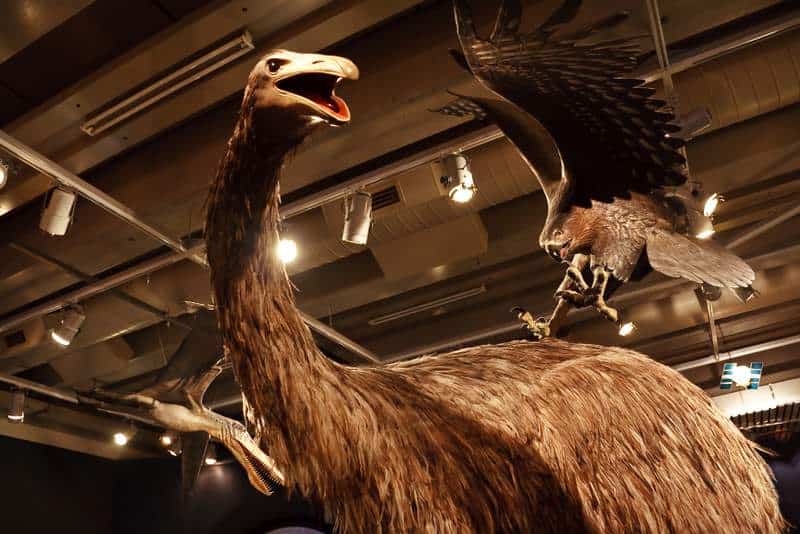
Recreation of a Haast’s eagle attacking a moa.
©Sergio Alexandro, CC BY 2.0 <https://creativecommons.org/licenses/by/2.0>, via Wikimedia Commons – License
How Large Was the Haast’s Eagle?
The Haast’s eagle is the largest and heaviest eagle to ever exist, weighing up to 37 pounds and measuring four feet long, with a nine to ten-foot wingspan. This enormous eagle had a bill larger than any living vulture and claws bigger than a tiger’s. Their main prey was moa, which could easily topple 12 feet high and weigh over 500 pounds! While the Haast’s eagle couldn’t necessarily fly off with a moa, they could use their sharp, powerful talons to rip through flesh and crush bone.
In comparison, the biggest of the bald eagles can only reach up to 14 pounds and measure three feet long, with a seven-foot wingspan. They typically eat fish, carrion, and small animals. But bald eagles have also been known to devour deer, pronghorns, and calves.
Could a Haast’s Eagle Pick Up a Human?
The Maori, indigenous Polynesian people of New Zealand, made cave drawings of giant eagles and described them through oral traditions. Based on their oral records, Haast’s eagles were known for attacking human children. While there is no concrete evidence that these eagles ate humans, researchers believe that the tales of Haast’s eagles swooping down on humans in the mountains may be true. They were fierce predators, capable of killing prey much bigger than they were.
As for bald eagles, there is no record of them flying off with or killing a human, including small children. At most, the bald eagle may be capable of snatching tiny dogs or cats.
Why Did the Haast’s Eagle Go Extinct?
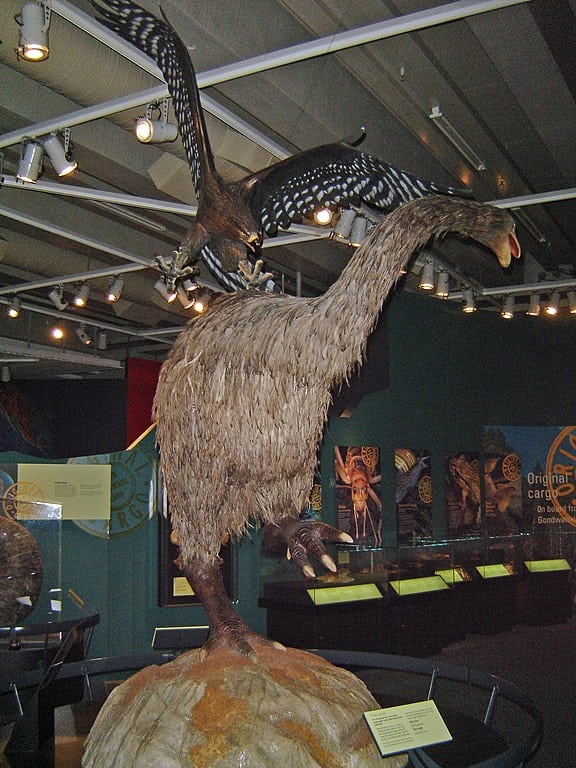
Apart from a decline in their prey species and a loss of habitat, Haast’s eagles were also hunted by locals, and their bones were made into tools.
©DO’Neil / CC BY-SA 3.0 – License
We don’t know exactly why the Haast’s eagle went extinct but humans are most likely to blame. Humans overhunted its moa prey into extinction and burned its dry forests and shrublands. Apart from a decline in their prey species and a loss of habitat, Haast’s eagles were also hunted by locals, and their bones were made into tools.
Could it Still Exist Today?
The Haast’s eagle would most likely not be alive today. The moa was their main food source, and they could not survive without them. These eagles went extinct around 1400 AD shortly after humans arrived on the islands, and have not been seen since.
Haast’s Eagle Vs Bald Eagle: Recap
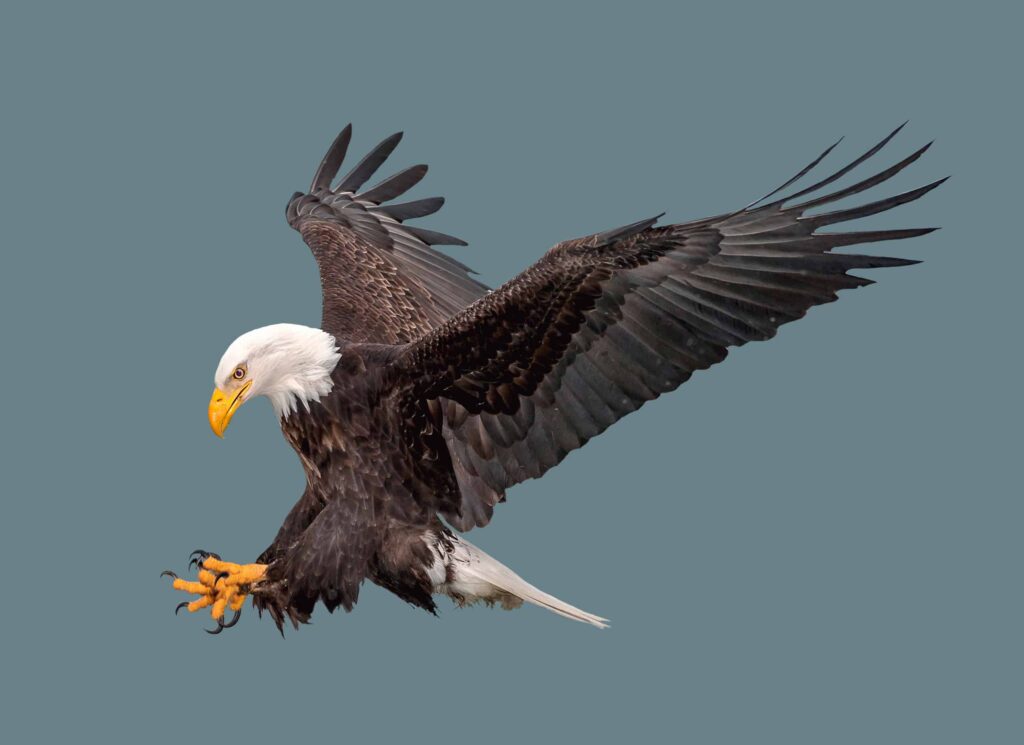
Haast’s eagles could reach up to 37 pounds and feature a ten-foot wingspan, while bald eagles don’t exceed 14 pounds.
©PHOTOOBJECT/Shutterstock.com
Bald eagles are still extraordinary in their own right, but Haast’s eagles would have been a magnificent sight as they soared across New Zealand skies. Haast’s eagles could reach up to 37 pounds and feature a ten-foot wingspan, while bald eagles don’t exceed 14 pounds. But the bald eagle still has an impressive wingspan, reaching over seven feet. The biggest difference comes in prey size. Bald eagles typically eat smaller animals, but the Haast’s eagle specialized in hunting one of the largest flightless birds ever.
The photo featured at the top of this post is © John Megahan / CC BY 2.5 – License / Original
Sources
- journal of the Ornithological Society of New Zealand, Available here: https://www.birdsnz.org.nz/wp-content/uploads/2021/12/Notornis_39_4_239.pdf
- PLOS Biology, Available here: https://journals.plos.org/plosbiology/article?id=10.1371/journal.pbio.0030009
- New Zealand Birds Online, Available here: https://nzbirdsonline.org.nz/species/haasts-eagle
- ABC News, Available here: https://abcnews.go.com/Technology/extinct-zealand-eagle-eaten-humans/story?id=8557686
Thank you for reading! Have some feedback for us? Contact the AZ Animals editorial team.





